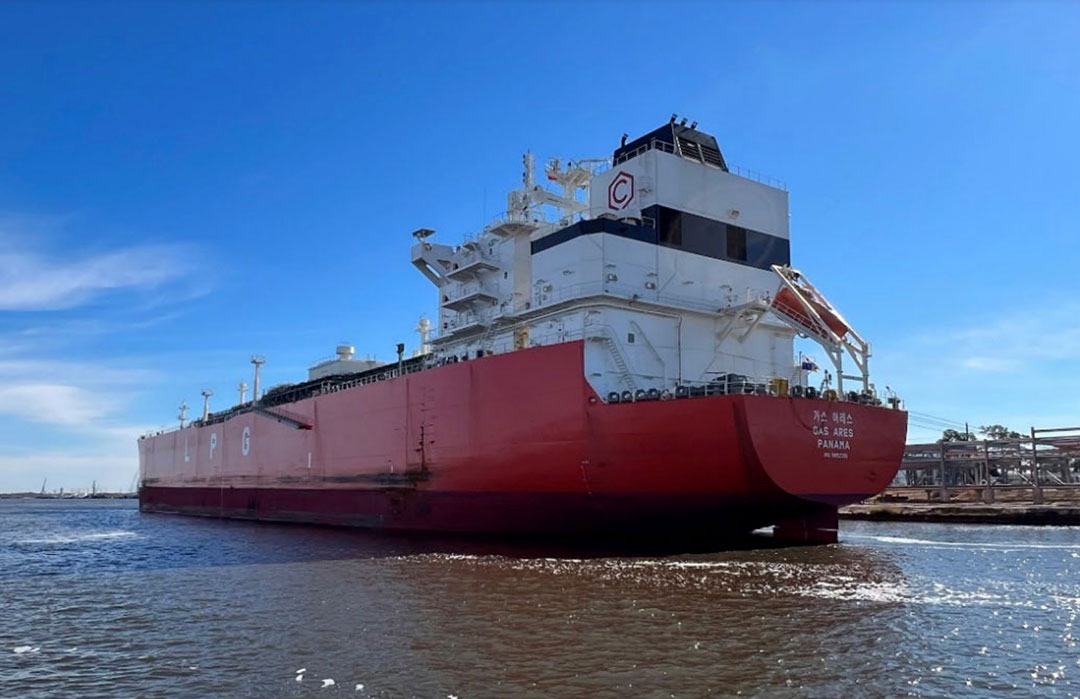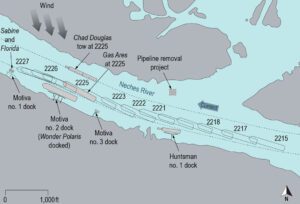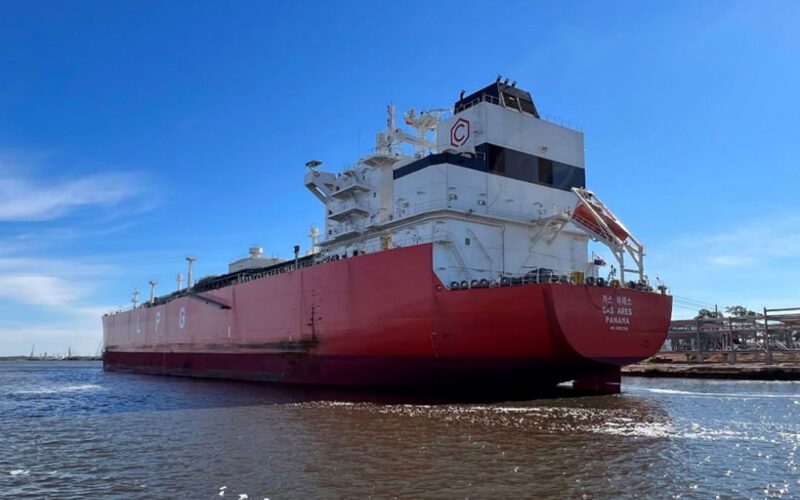
$1 million.
The liquefied petroleum gas (LPG) carrier Gas Ares was upbound in the Neches River near Port Neches, Texas, when the pilot conning the ship slowed the engine alongside a pipeline removal project.

The pilot, a senior deputy with the Sabine Pilots, wanted to create less wake as the ship passed vessels supporting the pipeline project, according to the National Transportation Safety Board (NTSB). Minutes later, Gas Ares hit the tugboat Sabine moored at the Motiva Port Neches Terminal. The impact pushed Sabine into another moored tug, Florida, which hit the Motiva dock.
No one was injured and there was no pollution in the incident, which happened at 2227 on Nov. 25, 2021. Total damage exceeded $1 million, nearly all to the Motiva No. 1 dock where the two tugs moored.
“With the pilot’s ordered reduction of the ship’s speed, Gas Ares’ rudder became less effective, and the pilot was not able to move the vessel to starboard and away from the nearby moored vessels by rudder and engine alone,” the NTSB said in its incident report.
“Without enough headway,” the report went on, “the pilot was unable to steer the vessel back to the center of the channel and avoid striking the moored Sabine at the Motiva No. 1 dock.”
The Sabine Pilots declined to comment on the NTSB findings, citing other ongoing investigations into the matter.
The Panama-flagged Gas Ares got underway from the Sabine Bank Anchorage at 1736 with the pilot and 23 crewmembers on board. The ship was in ballast after a voyage from South Korea. Its destination was a berth at Sunoco Logistics along the Neches River in Nederland, Texas.
Conditions at the time were overcast, with wind from the north at 15 knots, gusting up to 25, and 10 miles of visibility. The tide was coming in, pushing about 0.4 knots on Gas Ares’ stern.
The assist tugboat Hayley Moran met Gas Ares at Texaco Island, near Port Arthur, Texas. The tug’s crew got a line on the ship’s stern at 2024 and escorted the vessel up the Sabine Neches Canal. Another tractor tug had been ordered to assist with the docking.
Gas Ares made about 9 knots with its engine at half ahead at 2158 as it passed under the Rainbow Bridge east of Port Neches. The ship then entered a congested section of the Neches River. Up ahead, an articulated tug-barge (ATB) was moored at the No. 1 Huntsman Corp. dock on the west side of the river. The 144-foot-wide tanker Wonder Polaris was moored just upriver at the Motiva No. 2 dock. The downbound towboat Chad Douglas also approached the ship with three barges in tow.
Gas Ares proceeded along the west side of the channel, closest to the moored vessels. At 2211, the pilot ordered the vessel to decrease speed to slow ahead, and then a minute later to dead slow ahead, as it approached the pipeline removal work site where several vessels were tied up for the night. According to the NTSB report, the pilot wanted to avoid upsetting those vessels or injuring any people that might be on board.
“The pilot said that as Gas Ares slowed, the wind, ‘blowing from the north,’ started affecting the vessel’s maneuverability, setting it toward the moored ATB,” the report said.
By 2218 the ship’s speed had slowed to about 4 knots, and the pilot used Hayley Moran “to pull the vessel’s stern to starboard several times,” according to the NTSB.
The pilot first asked Chad Douglas to slow down to avoid meeting three abreast alongside the moored Wonder Polaris. But at 2222, she asked the towboat operator to “drive on it” because she was having a hard time controlling the ship. The towboat operator acknowledged the request and agreed to drive “straight on.”
The tow passed the ship at about 2225, around the time when Gas Ares approached the moored Wonder Polaris on its port side. The pilot ordered the 6,000-hp Hayley Moran to pull full power to starboard and issued engine and rudder commands to try and steer the ship back toward the center of the channel.
“The pilot’s efforts to use the stern tug to pull Gas Ares’ stern back to starboard and the center of the channel caused the LPG carrier’s bow to point more toward the left side of the channel and moored vessels,” the report concluded.
The pilot twice ordered five short blasts from the ship’s whistle to alert other nearby vessels, the report said. The captain aboard Sabine heard the whistle and saw Gas Ares bearing down on his tug. He sounded the general alarm and just before impact used the public address system to urge the three other crewmembers to hang on.
Gas Ares cleared Wonder Polaris but its port bow bumped Sabine at 2227, at about the same time a crewmember aboard the ship released its starboard anchor. Sabine and Florida were both able to get underway soon afterward. Gas Ares continued its voyage to the Sunoco dock later that night without incident.
The U.S. Coast Guard had issued several marine safety information bulletins alerting mariners to the pipeline removal project, which progressed during daytime hours outside the navigation channel. According to the NTSB, the pipeline removal crews made no request for passing vessels to slow down in their vicinity. However, the pilot told investigators their presence in the waterway required her to slow the passing ship.
“The pilot’s decision,” the NTSB said, “to order the vessel’s speed reduced in anticipation of passing the pipeline removal project was what initiated the eventual collision with Sabine at the Motiva No. 1 dock.”

